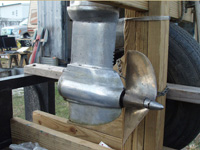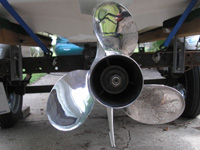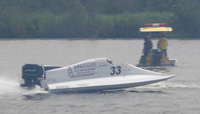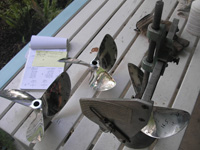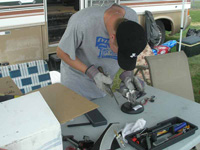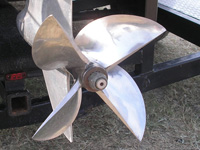Information on Props
Either read full article or just click on the following sections:
- Fully submerged vs. surface-piercing props
- Cupping
- How to improve both acceleration and top end
- You need enough blade area in the right places
- Rake
- Baumann Propeller
- World speed Records set by antique Outboards
Fully submerged vs. surface-piercing props
Fully submerged propellers create much more drag and operate less efficiently on a light, fast boat (pad V-bottom, tunnel, hydro) than do surface-piercing props. An example of a fully-submerged prop is a shortshaft motor (15" downhousing) set at a transom height less than 17 ½". This set-up is plagued by cavitation problems when enough power is applied in an attempt at high speed. The solution, known since at least 1950, is nonintuitive: jack up the motor and get up to half the prop out of the water! Surface-piercing means that at least part of one blade runs 'dry' during each revolution. This configuration avoids cavitation by sucking in air as each blade re-enters the water ('ventilation').
Researchers do not know exactly how ventilation works, but racers have long known how to use surface-piercing props to gain speed and acceleration. This type setup is now fairly common with all large outboards on reasonably fast big boats. In contrast with the bronze and aluminum props of the 1950s, props built for surfacing application generally have a flat high pressure side and convex low pressure side. The 1950s era props were built in the style of an airfoil, with both sides of the blade convex. In 1960 80hp on an Allison would break 60 mph. In 1981 75 hp on an Allison broke 70 mph. The motors and boats were about equally fast, the difference was in the prop and setup. In 1960 we ran a bronze prop in 1960 at a transom height of about 19". In 1981 I ran a self-reworked OMC cleaver at a transom height of about 22.5". Speed and acceleration are all about drag reduction and prop efficiency.
Cupping
Many outboarders learn that a prop must be cupped if you want to jack up the motor higher than about 18". The cavitation plate on a shortshaft motor (15" downhousing/midsection) is slightly above the waterline at about 17 5/8". With a shortshaft motor, the tip of the prop blade starts piercing the water at transom heights of 18" (or at 23" for a 20" downhousing/midsection). A shortshaft motor on a fast pad v-bottom like an Allison will run 21-22" high on the transom, with no jackplate to place the gearcase farther downstream of the pad. Any time the blade tip pierces the water surface the prop must be cupped, otherwise the RPM is unnecessarily high and the prop efficiency is very low. The cup on the trailing edge works just like the flap on an airplane wing: the pilot drops the flap to increase the lift on the wing. Airfoil theory has been well-understood since 1916, it was explained by a German engineer named Prandtl.
If the motor's jacked up and you have a rooster tail shooting upward, then you're losing prop efficiency: the water should be thrown back parallel to the direction of travel.
'Cup' should feather rapidly to zero at maximum blade radius. Cupping beyond that will make the prop 'catch' faster and will reduce the top speed. Next is about drag reduction.
How to improve both acceleration and top end
Less well-known than cupping is that the leading edge of each blade should be set in a certain way. We know how set both cup and leading edge pitch correctly, we've built our own racing props since 1978. We could cup a 1950s era bronze prop fairly well using a ballpeen hammer on a chrome car bumper, but you cannot set the leading edge of a surface-piercing prop correctly without a pitch gauge, knowledge of gear ratio, RPM and speed at full throttle. It's highly unlikely that a normal prop shop will know how to do this. The idea, discovered by Joe in 1978 and used to set three speed records and win many closed course races, was never published but is now taken for granted in the 'surface-drive' industry. Here's the main point: when both trailing and leading edge are set correctly by using a pitch gauge, then you gain both top speed and acceleration. The prop that Joe used to set the EP Class straightaway record at 70.560 mph in 1981 (stock Evinrude 75 on a 14' Allison) was the same prop that he used to win many closed course races afterward, including with le Manns starts.
You need enough blade area in the right places
For the optimal set-up, each prop has an optimal diameter and optimal pitch. The diameter must be found by experimentation. Optimal performance is never achieved by trimming the tip or trailing edge of a blade, or by cutting off a section the trailing edge. The slope of the blade's edge at tip is very important, a typical mistake there increases the drag while providing no benefit.
A propeller traces out a helical path and leaves behind a multi-helical wake, one helix for each blade. The pitch of the helix is less than the pirch of the prop blades. This effect is colloquially called 'slip', but a prop does not move through water for the same reason that a screw travels through a solid. Instead, a prop blade operates exactly the same way as an airfoil or a sail, except that it rotates at high speed. The pitch of the screw that would trace out this helix is the pitch of the helix. Blade angle and pitch are related by a very simple formula. The thicker the helical wake, the greater the drag. This is why prop blades are thin. With high speed outboards, most of the drag is due to the prop and gearcase, very little of the boat touches the water. The higher you can run the motor, the faster it will go. That's why catamarans are fast, there's no distuerbance of the inflow to the prop so you can run the motor with the gearcase bullet completely above the water and the tunnel will still turn. But what about rake?
Rake
Imagine a plane perpendicular to the propshaft axis, with a pitch the same as at the blade's mid-section, e.g. 'Rake' is the angle of the blade relative to this plane. A zero-rake surfacing prop, typical on the old inboard hydros, tends to climb toward the surface, lifting the transom. This is how hydros 'prop-ride'. A blade with positive rake tends experiences a downward force that makes the gearcase want to go deeper. This effectively increases the trim angle and thereby increases the water pressure at the transom dynamically. With increased positive trim the boat runs with less surface in the water and the bow rides higher. In common but wrong parlance, the positive rake generates 'bow lift'. But as Louis J. Baumann says, and I agree, there's no such thing as 'bow lift', there is only a downward force on the prop blade.
Baumann Propeller
In 1977-78, Louis J. Baumann built two props for Joe that won three EP class national championships. Joe learned to work on props at Baumann Propeller in 1978-79 when Louis J. kindly let him use the for no charge. Joe built five racing props for himself there, four of which were very successful. Those props set 3 speed records, and won another national championship in 1981. Hans is now lecarning all the tricks of the trade.
World speed records set by antique outboards
An Eldridge X-outboard driven by Clinton Ferguson set the outboard world speed record at 79.44 mph in 1939. From 1935-1939 the outboard world speed record see-sawed back and forth between three OMCs with the Walker-Baumann tractor gearcase, and three 4-stroke Soriano outboards with combination 'tractor/push' gearcase (one prop in front of and one behind the gearcase)-see Joe's article in the April 2011 Antique Outboarder magazine, the quarterly publication of the AOMC. Then in 1939 the record was reclaimed by a Soriano with a DuPuy 'overdrive' gearcase. Four-stroke Sorianos and Lescos kept the record through 1957. A Lesco/DuPuy set the record at over 100 mph ca. 1954. The record was increased to over 107 mph in 1957 by an alky-burning Mercury Mark 75H driven by aircraft engineer Hugh Entrop. Marc Hamer collects and restores Soriano outboards. You can visit his website at www.soriano-outboard.com.
Links and References
The Propeller Handbook, Dave Gerr, Int. Marine, 2001
www.texaschapteraomci.com
www.aomci.org
The Antique Outboarder (AOMCI quarterly), especially issues
July 2010, April 2011.
www.soriano-outboard.com

